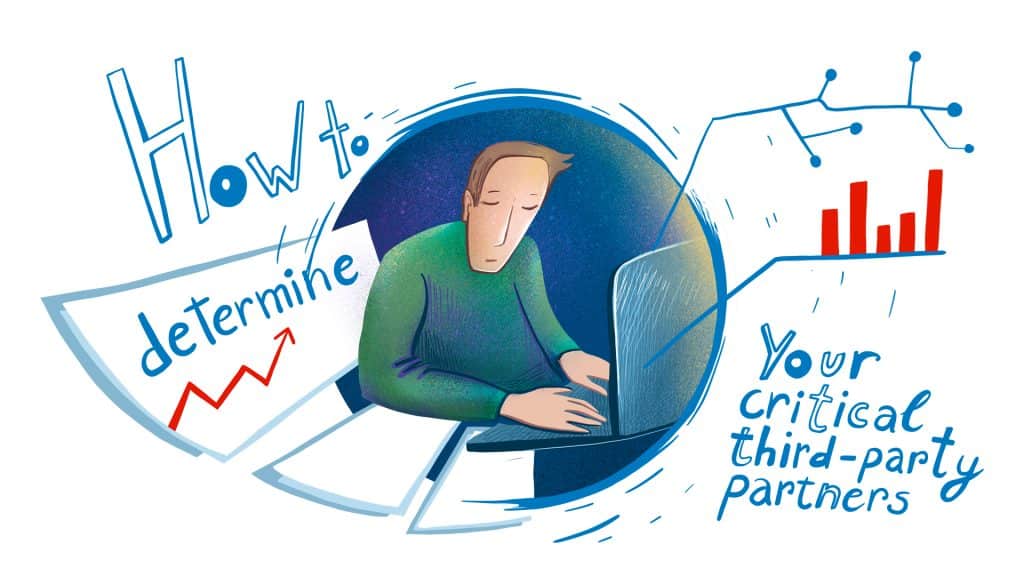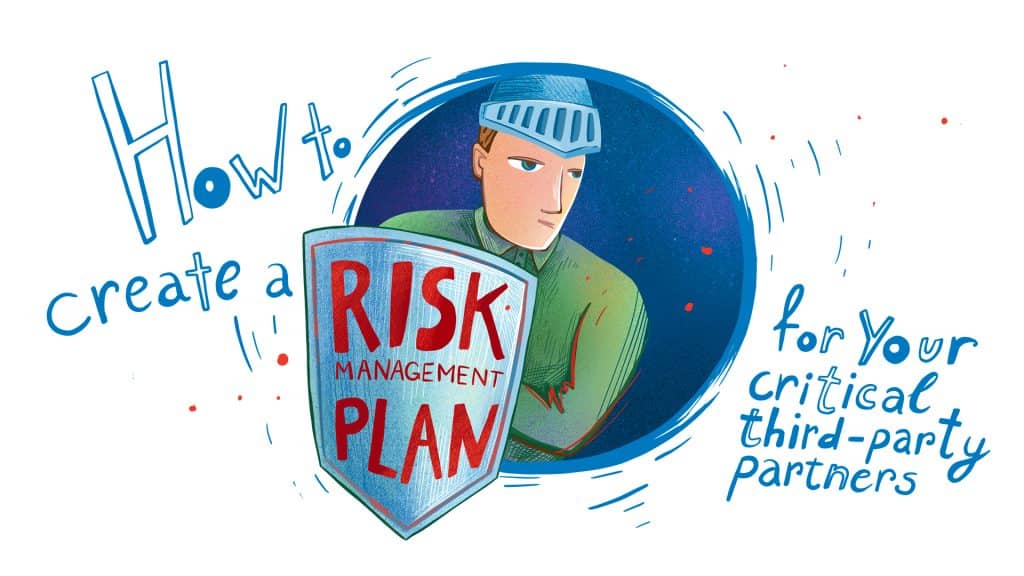
Like it or not, a big part of running a successful omnichannel ecommerce business is building and maintaining partnerships with a number of third-party vendors. These include the businesses that handle tasks like supplying your materials, transporting your goods, processing your transactions, handling your cash flow, managing your inventory, and advertising your products.
When it comes to your company, it is important to recognize that not all third-party vendors are created equal. You likely have a mix of both critical and non-critical vendors.
By definition, critical third-party vendors are the partners that are so instrumental to your day-to-day operations that, should they fail to live up to expectations, they would cause significant harm to your business and/or your customers.
Non-critical third-party vendors, however, are the partnerships that exist on the periphery of your business: they typically do not handle sensitive business or customer data, are not crucial components of your core business operations, and ultimately can be replaced or cut out more easily than a critical vendor.
While you need to be sure to regularly conduct audits of all the vendors and suppliers your business deals with, your most critical vendors are partnerships that will require both extra attention and extra scrutiny.
How to Determine Your Ecommerce Business’s Critical Third-Party Vendors
Every ecommerce business needs to be able to differentiate its critical vendors from its non-critical vendors. There are several factors to consider when making this determination. Losing a critical vendor can be detrimental to your ecommerce business, but so can a vendor’s operational failures.
Some simple questions you could ask to identify a vendor include:
Would the loss of the vendor, the vendor’s security being compromised, and/or the failure of a vendor to meet contractual expectations…
- Leave your business without the inventory needed to operate?
- Compromise customer data?
- Compromise sensitive or proprietary business information?
- Cause financial harm to your business—either an inability to process orders or access funds?
- Impair your ability to service entire geographic regions?
- Lead to operational downtime of more than 24 hours?
- Leave your business vulnerable to legal or financial scrutiny?
- Hamper your ability to remain compliant with third-party marketplace terms of service?
- Make it impossible to meet your own contractual demands?
- Cause harm to your business’s reputation?
Answering ‘yes’ to any of the questions above is a good sign that you have identified a critical vendor to your ecommerce brand. These are all examples of significant risks that could derail your business in the short and/or long term.
How to Create a Risk Management Plan for Your Critical Third-Party Partners
Critical vendors are critical for a reason: your business needs them. The interconnected nature of the ecommerce industry makes these relationships both indispensable and unavoidable. Even though critical third-party vendors carry inherent risks, you can mitigate these risks by establishing and maintaining risk management plans.
While you should hold all vendors accountable to a consistent set of standards, the complexities of the outside goods and services ecommerce businesses rely on means that there is no such thing as a truly one-size-fits-all risk management plan.
Different third-party partners pose their own set of unique risks—often proportional to the degree to which your company needs their support in order to function. That said, there are some general risk management categories that should be considered for each new and existing third-party vendor you partner with:
Cybersecurity Risk Management
This is particularly important for third parties that have access to sensitive business and/or customer data. You need to establish comfort and confidence in the IT infrastructure of third-party businesses that interact with your brand’s sensitive digital information and your own internal IT systems.
Operational Risk Management
If a third party has the ability to stall, hinder, or even shut down your ability to operate, they pose an operational risk. These third parties need to demonstrate the contingencies and failsafes they put in place to be able to provide your ecommerce business with continuous, reliable service.
Financial Risk Management
Any third party that has access to your financials, lines of credit, or actual funds can pose a serious threat to your ability to keep your business solvent. Furthermore, cost spikes for goods and services can also pose impactful financial risks—particularly when the goods and services are some of the most critical to your business.
Compliance Risk Management
Online retail is fraught with terms and conditions that must be met to keep marketplace accounts in good standing while also abiding by local, state, federal, and international regulations.
Reputational Risk Management
Growing an ecommerce brand requires consumer confidence and satisfaction. Your third-party vendors must be able to deliver for you so that you can maintain acceptable customer satisfaction levels. Not only that, your third-party vendors must be able to demonstrate the ability and willingness to meet or exceed the same reputational standards that you hold your own company to.
This includes their marketing decisions, legal compliance, social media presence, political endorsements, and any other forward-facing elements of their operations that might have a negative impact on your brand by association. Since not every category will apply to every third-party, you will need to create risk management plans suited to the vulnerabilities and exposures for each vendor.
However, having boilerplate language at the ready for specific types of risks can simplify the creation of management plans. Proactively establishing this language with your leadership and legal teams should be a priority.

Put Your Third-Party Vendor Risk Management Plans Into Action
Once risk management plans have been established, ongoing monitoring is essential. Annual reviews are a good starting point, but your most critical vendors need to be continually assessed.
By nature, critical vendors are so important to keeping your business flowing that any issue could cause an immediate interruption in your ability to deliver for your customers—meaning that you can’t afford to wait months for the next scheduled review.
Part of any risk management plan should include performance metrics that are routinely scrutinized, as well as non-negotiable mitigation plans that go into effect immediately if a problem should occur. Should red flags arise—like a security breach, a sudden price spike, or a quality control issue—mitigation needs to begin immediately.
There may be certain violations that are so egregious that they lead to the end of a relationship, but the more critical a vendor, the more difficult and unwise it may be to sever a partnership that can be salvaged (or at least salvaged enough to buy you time to find a replacement).
As such, your risk management plan should always include specific remediation steps tied to strict timetables. Of course, failure to respond acceptably to these expectations would likely lead to the beginning of the offboarding process.
Offboarding a critical vendor is never a desirable outcome. Nevertheless, it is something that you need to plan for. Depending upon the service(s) provided by the third-party vendor, this process can vary in its complexity.
Doing so smoothly means ensuring that contracts are completed, funds are transferred correctly, IT connections are severed securely, and physical goods and equipment are all returned. You will also want to be sure to document the entire offboarding process—including the reasons for the separation.
This will help shield your business from potential liabilities and provide useful insights for future vendor evaluations. The consequences of a rushed and/or flawed offboarding process can be great.
For that reason, offboarding should absolutely be included in every critical vendor risk management plan. All told, risk management plans are most effective when they are both comprehensive and actionable. They become the guiding document for navigating your business’s most invaluable outside partnerships.
Descartes Sellercloud Can Help You Manage and Monitor Your Third-Party Partners
In addition to applying a rigorous set of security and risk management standards within our platform, Descartes Sellercloud makes it possible to establish smooth and secure data transfers with your third-party partners.
We offer native and secure API and EDI integrations with third-party vendors and services that can help you operate and grow as an omnichannel ecommerce business.
What’s more, Descartes Sellercloud’s order tracking, inventory management, and accounting features can make it easier to monitor and detect anomalies with your third-party vendors—all from a single, secure, cloud-based interface.
Among other benefits, this combination of convenience and reliability helps you avoid potential issues with outside partners and vendors.
For more about how Descartes Sellercloud can help you onboard and monitor some of the best growth-focused third-party partners in the ecommerce industry, contact us directly for a free demo.




